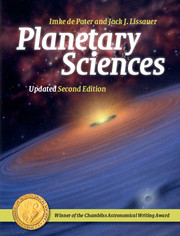Book contents
- Frontmatter
- Contents
- List of Tables
- Preface
- 1 Introduction
- 2 Dynamics
- 3 Solar Heating and Energy Transport
- 4 Planetary Atmospheres
- 5 Planetary Surfaces
- 6 Planetary Interiors
- 7 Magnetic Fields and Plasmas
- 8 Meteorites
- 9 Minor Planets
- 10 Comets
- 11 Planetary Rings
- 12 Extrasolar Planets
- 13 Planet Formation
- Appendix A List of Symbols Used
- Appendix B Acronyms Used
- Appendix C Units and Constants
- Appendix D Periodic Table of Elements
- Appendix E Observing Techniques
- Appendix F Interplanetary Spacecraft
- Appendix G Recent Developments in Planetary Sciences
- References
- Index
- Plate Section
- References
7 - Magnetic Fields and Plasmas
Published online by Cambridge University Press: 05 January 2015
- Frontmatter
- Contents
- List of Tables
- Preface
- 1 Introduction
- 2 Dynamics
- 3 Solar Heating and Energy Transport
- 4 Planetary Atmospheres
- 5 Planetary Surfaces
- 6 Planetary Interiors
- 7 Magnetic Fields and Plasmas
- 8 Meteorites
- 9 Minor Planets
- 10 Comets
- 11 Planetary Rings
- 12 Extrasolar Planets
- 13 Planet Formation
- Appendix A List of Symbols Used
- Appendix B Acronyms Used
- Appendix C Units and Constants
- Appendix D Periodic Table of Elements
- Appendix E Observing Techniques
- Appendix F Interplanetary Spacecraft
- Appendix G Recent Developments in Planetary Sciences
- References
- Index
- Plate Section
- References
Summary
The secret of magnetism, now explain that to me! There is no greater secret, except love and hate.
Johann Wolfgang von Goethe, in Gott, Gemüt und WeltMost planets are surrounded by huge magnetic structures, known as magnetospheres. These are often more than 10–100 times larger than the planet itself, and therefore form the largest structures in our Solar System, other than the heliosphere. The solar wind flows around and interacts with these magnetic ‘bubbles’. A planet's magnetic field can either be generated in the interior of the planet via a dynamo process (Earth, giant planets, Mercury), or induced by the interaction of the solar wind with the body's ionosphere (Venus, comets). Large-scale remanent magnetism is important on Mars, the Moon, and some asteroids.
The shape of a planet's magnetosphere is determined by the strength of its magnetic field, the solar wind flow past the field, and the motion of charged particles within the magnetosphere. Charged particles are present in all magnetospheres, though the density and composition varies from planet to planet. The particles may originate in the solar wind, the planet's ionosphere, or on satellites or ring particles whose orbits are partly or entirely within the planet's magnetic field. The motion of these charged particles gives rise to currents and large-scale electric fields, which in turn influence the magnetic field and the particles' motion through the field.
Although most of our information is derived from in situ spacecraft measurements, atoms and ions in some magnetospheres have been observed from Earth through the emission of photons at ultraviolet and visible wavelengths. Accelerated electrons emit photons at radio wavelengths, observable at frequencies ranging from a few kilohertz to several gigahertz. Radio emissions at ∼10 MHz were detected from Jupiter in the early 1950s, and formed the first evidence that planets other than Earth might have strong magnetic fields.
The Interplanetary Medium
7.1.1 Solar Wind
The presence of corpuscular radiation from the Sun, the solar wind, was first suggested by L. Biermann in 1951 based on the observation that cometary ion tails always point away from the Sun.
- Type
- Chapter
- Information
- Planetary Sciences , pp. 283 - 336Publisher: Cambridge University PressPrint publication year: 2015



